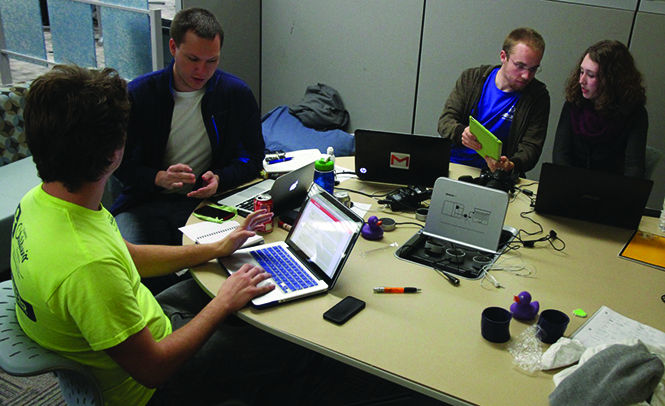Ohio’s Largest Hack-a-thon brings innovation to Kent State
Dakota Grover, Michael Bickerton, Jim Jastatt and Ashley Choi work together during the Hackathon on Saturday, Oct. 19, 2013.
October 21, 2013
Kent State hosted the largest hack-a-thon in Ohio this weekend, with more than 150 students from various locations across the country participating in a 40-hour hacking experience.
Four students from the University at Buffalo created an extension to Google Chrome, called scrolr, which won first place.
Scrolr uses a face recognition system to allow hands-free scrolling on the Internet. “This will change the way we use the Internet,” group member Mack Ward said.
The group received $1,000 and a $3,000 credit to Amazon Web Services.
Students and sponsors gathered in University Library on Friday at 6 p.m. for an introduction, which included rules, prizes and sponsor announcements. Hacking began around 7:30 p.m. until 11 a.m. Sunday.
Scattered around the fourth floor of the library, hackers worked in groups of one to four participants, with energy drinks covering tables and sleeping bags strewn on the floors.
In the 40 hours students spent hacking, they were offered food, drinks, a session from Amazon Web Services and even yoga.
Sponsors of this year’s hack-a-thon included Flashstarts, Hyland Software, Blackstone Launch Pad, Kent Displays Inc. and Google.
Amazon Web Services employer Trevor Hike said he uses these gatherings to look for future employers.
Hack-a-thons “give students a chance to interact with technology companies as well as peers,” said Daniel Gur, co-founder of Kent State’s HacKSU.
Upon arrival, students created teams and began brainstorming ideas, as all work had to be done in the 40-hour time limit and had to be original work.
By 2 p.m. Saturday, students began to look drained due to the lack of sleep, challenges faced with programming and some team dismemberment.
One of the most important aspects of hack-a-thons is students that are all skilled in different areas coming together and helping one another, said HacKSU co-founder Camden Fullmer.
“At the @KentHackEnough hack-a-thon, getting an incredible amount of work and research done. Very excited for what the future entails,” sophomore entrepreneurship major Anthony Milia tweeted.
After teams submitted their creations, each was allotted about five minutes to present their ideas to the panel of judges made up of computer science professor, Dr. Mikhail Nesterenko; chief software architect at Explorys, Doug Meil; and fashion technologist and assistant professor Margarita Benitz.
Teams were judged on the usefulness of their project, the originality, the polish and design of the website, app or game and technical difficulty.
“We were truly impressed with what the teams came up with,” Nesterenko said about the 11 teams that presented ideas.
The judging panel agreed that the scrolr group created a smooth execution and its presentation was enjoyable to watch.
The team said they had fun working on their creation and came up with the idea because “sometimes you are doing other things and don’t have a free hand to scroll, so why not use your head,” Ward said.
Scrolr, along with the other 10 creations from the weekend, can be seen at www.kenthackenough.challengepost.com/submissions.
Contact Taylor Williams at [email protected].

























